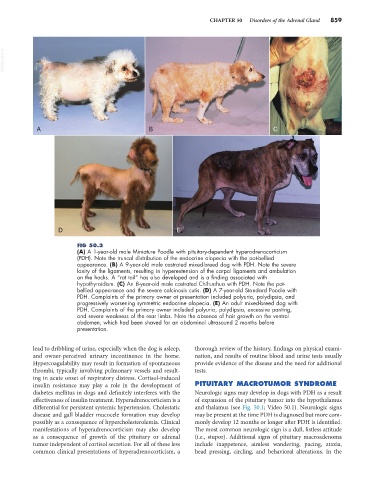Page 887 - Small Animal Internal Medicine, 6th Edition
P. 887
CHAPTER 50 Disorders of the Adrenal Gland 859
VetBooks.ir
A B C
D E
FIG 50.3
(A) A 1-year-old male Miniature Poodle with pituitary-dependent hyperadrenocorticism
(PDH). Note the truncal distribution of the endocrine alopecia with the pot-bellied
appearance. (B) A 9-year-old male castrated mixed-breed dog with PDH. Note the severe
laxity of the ligaments, resulting in hyperextension of the carpal ligaments and ambulation
on the hocks. A “rat tail” has also developed and is a finding associated with
hypothyroidism. (C) An 8-year-old male castrated Chihuahua with PDH. Note the pot-
bellied appearance and the severe calcinosis cutis. (D) A 7-year-old Standard Poodle with
PDH. Complaints of the primary owner at presentation included polyuria, polydipsia, and
progressively worsening symmetric endocrine alopecia. (E) An adult mixed-breed dog with
PDH. Complaints of the primary owner included polyuria, polydipsia, excessive panting,
and severe weakness of the rear limbs. Note the absence of hair growth on the ventral
abdomen, which had been shaved for an abdominal ultrasound 2 months before
presentation.
lead to dribbling of urine, especially when the dog is asleep, thorough review of the history, findings on physical exami-
and owner-perceived urinary incontinence in the home. nation, and results of routine blood and urine tests usually
Hypercoagulability may result in formation of spontaneous provide evidence of the disease and the need for additional
thrombi, typically involving pulmonary vessels and result- tests.
ing in acute onset of respiratory distress. Cortisol-induced
insulin resistance may play a role in the development of PITUITARY MACROTUMOR SYNDROME
diabetes mellitus in dogs and definitely interferes with the Neurologic signs may develop in dogs with PDH as a result
effectiveness of insulin treatment. Hyperadrenocorticism is a of expansion of the pituitary tumor into the hypothalamus
differential for persistent systemic hypertension. Cholestatic and thalamus (see Fig. 50.1; Video 50.1). Neurologic signs
disease and gall bladder mucocele formation may develop may be present at the time PDH is diagnosed but more com-
possibly as a consequence of hypercholesterolemia. Clinical monly develop 12 months or longer after PDH is identified.
manifestations of hyperadrenocorticism may also develop The most common neurologic sign is a dull, listless attitude
as a consequence of growth of the pituitary or adrenal (i.e., stupor). Additional signs of pituitary macroadenoma
tumor independent of cortisol secretion. For all of these less include inappetence, aimless wandering, pacing, ataxia,
common clinical presentations of hyperadrenocorticism, a head pressing, circling, and behavioral alterations. In the

